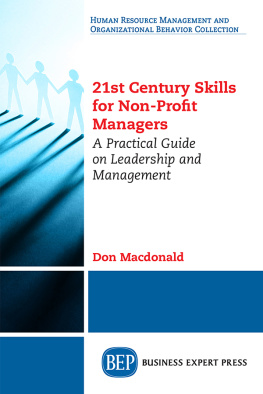CONTENTS

Copyright 2012 by John Wiley & Sons, Inc. All rights reserved.
Published by Jossey-Bass
A Wiley Imprint
One Montgomery Street, Suite 1200, San Francisco, CA 94104-4594 www.josseybass.com
No part of this publication may be reproduced, stored in a retrieval system, or transmitted in any form or by any means, electronic, mechanical, photocopying, recording, scanning, or otherwise, except as permitted under Section 107 or 108 of the 1976 United States Copyright Act, without either the prior written permission of the publisher, or authorization through payment of the appropriate per-copy fee to the Copyright Clearance Center, Inc., 222 Rosewood Drive, Danvers, MA 01923, 978-750-8400, fax 978-646-8600, or on the Web at www.copyright.com . Requests to the publisher for permission should be addressed to the Permissions Department, John Wiley & Sons, Inc., 111 River Street, Hoboken, NJ 07030, 201-748-6011, fax 201-748-6008, or online at www.wiley.com/go/permissions .
Limit of Liability/Disclaimer of Warranty: While the publisher and author have used their best efforts in preparing this book, they make no representations or warranties with respect to the accuracy or completeness of the contents of this book and specifically disclaim any implied warranties of merchantability or fitness for a particular purpose. No warranty may be created or extended by sales representatives or written sales materials. The advice and strategies contained herein may not be suitable for your situation. You should consult with a professional where appropriate. Neither the publisher nor author shall be liable for any loss of profit or any other commercial damages, including but not limited to special, incidental, consequential, or other damages. Readers should be aware that Internet Web sites offered as citations and/or sources for further information may have changed or disappeared between the time this was written and when it is read.
Jossey-Bass books and products are available through most bookstores. To contact Jossey-Bass directly call our Customer Care Department within the U.S. at 800-956-7739, outside the U.S. at 317-572-3986, or fax 317-572-4002.
Wiley publishes in a variety of print and electronic formats and by print-on-demand. Some material included with standard print versions of this book may not be included in e-books or in print-on-demand. If this book refers to media such as a CD or DVD that is not included in the version you purchased, you may download this material at http://booksupport.wiley.com . For more information about Wiley products, visit www.wiley.com .
Library of Congress Cataloging-in-Publication Data
Green, Alison.
Managing to change the world: the nonprofit managers guide to getting results / Alison Green and Jerry Hauser, The Management Center. First edition.
pages cm
Summary Includes bibliographical references.
ISBN 978-1-118-13761-1 (pbk.); ISBN 978-1-118-20590-7 (ebk)
1. Nonprofit organizationsManagement. I. Hauser, Jerry. II. Title.
HD62.6.G74 2012
658.048dc23
2011052644
FIRST EDITION
LIST OF TOOLS
| Delegation Worksheet |
| Sample Project Plan |
| Sample Goal Development Process |
| Sample Success Sheet: Setting Goals |
| Sample Organizational Goals |
| Sample Statement of Core Values |
| Sample Check-In Meeting Agenda |
| Sample Check-In Success Sheet |
| Sample Job Posting |
| Sample Talent List |
| Sample Worksheet for Building the Applicant Pool |
| Sample Rejection E-Mails |
| Sample Job Simulation Exercises |
| Sample Interview Preparation E-Mail |
| Sample Interview Questions |
| Sample Interview Outline |
| Sample Reference Check Questions |
| Sample Orientation Outline |
| Feedback Worksheet |
| Sample 2 2 Feedback Form |
| Sample Completed Evaluation Form for a Corrective Assessment |
| Sample Completed Evaluation Form for a Strong Assessment |
| Sample Retention Chart |
| Sample Progressive Discipline Policy |
| Sample Script for Informal Performance Warning |
| Sample Formal Performance Warning in Writing |
| Sample Firing Script |
| Sample Coaching-Out Script |
| Sample Daily List |
| Sample Weekly-Plus List |
| Sample Division of Labor Plan |
CHAPTER 1
THE JOB OF A MANAGER
We bet you had trouble finding the time to read this book. If so, its probably because youre feeling serious stress, like many of the nonprofit leaders with whom we work. Youre under pressure from funders, your staff, constituents, perhaps your boss, and ultimately yourself, to be getting more done. Too much of the burden of making things happen is falling on you.
Effective managementhow you get things done through other peoplecould help you accomplish more with less stress, but you may not know where to start. And if thats the case, youre not alone. Nonprofit leaders often end up in their roles not because theyre great managers, but because they are experts on a particular issue or excel at a specific function like communications or program design. If youre one of these talented, committed people, you may have been highly effective at getting results on your own, but you may now have hit the point in your career where your impact will be more a function of what you get done through others than what you do directly yourself.
Fortunately, good management is pretty straightforward. Our goal in writing this book was to create an easy-to-use manual with hands-on, practical advice and tools that will help nonprofit managers get better results in their work. Well cover a range of skills, representing what we think are the most important areas for managers to masterfrom delegating tasks, to setting and holding people accountable to clear goals, to hiring and firing, to staying organized and using your own time effectively. Exercised properly, these practices will make your life much easier.
Most important, though, not only does good management make your life easier, but it also makes it easier for you to get great results.
Although this probably sounds obvious, as managers ourselves we didnt automatically grasp it from the start. Jerrys first real management experience came at Teach For America, a large, national nonprofit where, as the second in command, he was responsible for managing the day-to-day work of the organization. A former teacher, he had been drawn to management partly because he liked seeing people learn and develop to their full potential. He wanted staff members to be happy and fulfilled in their work, and he viewed it as his job to mentor them so that they grew and developed.
That was fine as far as it went, but Teach For America had ambitious aspirations: it was trying to triple in size, raise the quality of its teachers, strengthen its alumni network, raise more money, and build a stronger organization to make it all happen. Early in Jerrys tenure, when he was more focused on mentoring and viewing his staff members satisfaction as an end goal, he wasnt always producing the kind of progress that was needed. Most of his staff members worked extremely hard, but not everyone did. And many excelled at their jobs, but in several critical cases, the organizations needs had outgrown his staff members skills.











